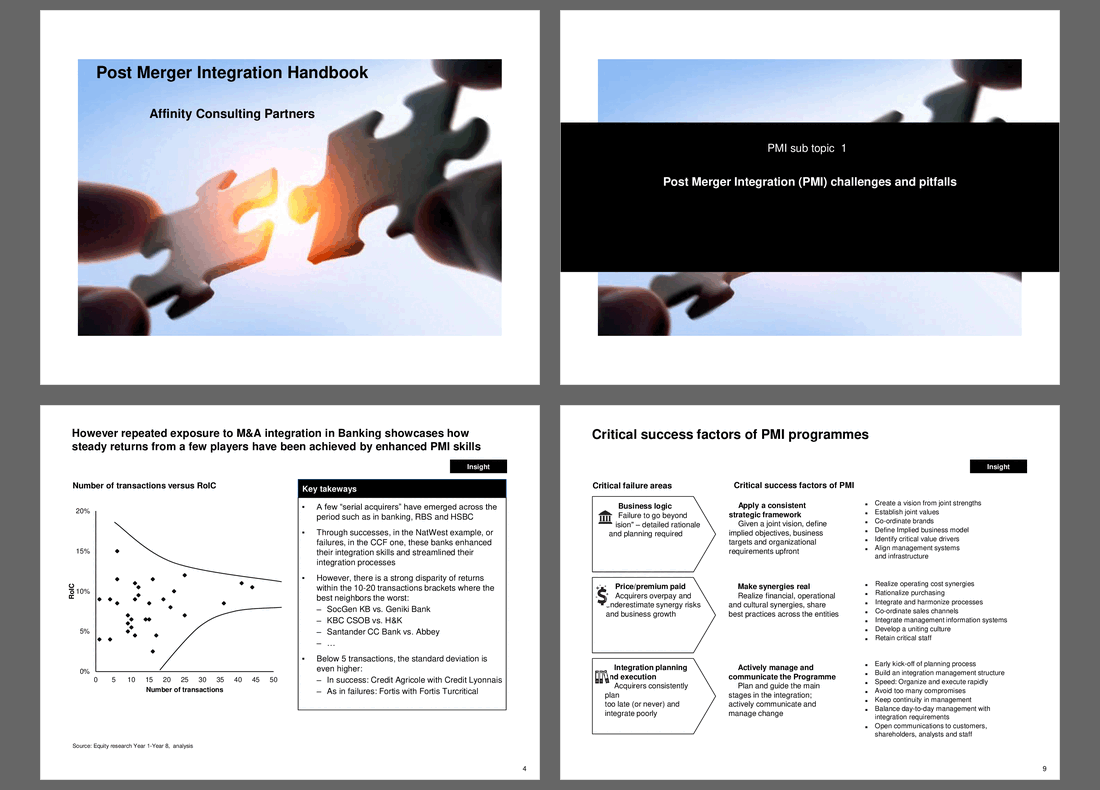







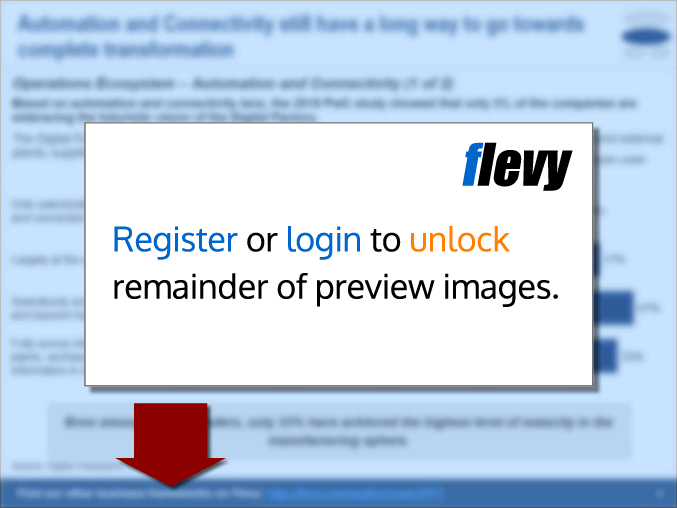








Please login here to save this document to a list.
If you don't have an account, you can register for free here.
Post Merger Integration (PMI) Handbook (PowerPoint PPTX Slide Deck)
PowerPoint (PPTX) 157 Slides
BENEFITS OF THIS POWERPOINT DOCUMENT
- Post Merger Integration
- Programme Management Office
- Large Scale Transformation
PMI PPT DESCRIPTION
The invaluable insights presented in this comprehensive PowerPoint deck are the culmination of the vast expertise and experience of over 30 former senior management consultants from renowned firms such as BCG, McKinsey, Bain, Accenture, and Deloitte. With a collective background in tier 1 management consulting, these seasoned professionals have actively participated in more than 50 global engagements across diverse industries and sectors. Their hands-on involvement in challenging real-world projects has provided them with a deep understanding of the complexities and intricacies of post-merger integration and large-scale global projects. Drawing from their extensive experiences and leveraging their profound knowledge, these experts have meticulously compiled these insights to offer pragmatic and actionable guidance for successful PMI and project management endeavors. As a result, this resource stands as a testament to the collective wisdom and expertise of a highly accomplished team, ensuring its value and relevance for organizations navigating the dynamic landscape of transformative business initiatives.
The core objectives of this resource are threefold:
Providing an Informative Overview of PMI: Gain a comprehensive understanding of the intricacies of the PMI process, exploring its strategic importance and potential impact on organizational success.
Implementing Best Practices in PMI: Acquire valuable insights into proven methodologies and industry-leading strategies for successful PMI execution. This deck offers guidance to navigate the complexities of integration with precision and efficiency.
Empowering Project Management: While the primary focus is on PMI projects, this resource serves as a valuable reference for larger initiatives that require a program management office (PMO) component. Discover guiding principles that extend beyond PMI, enhancing communication and governance practices in diverse projects.
Successful PMI projects necessitate careful alignment of project structure, setup, integration strategy, and processes to the unique characteristics of each case. Elements such as transaction structure, corporate strategy, organization, and cultural context significantly influence the PMI landscape.
Beyond PMI endeavors, this deck proves beneficial for projects of substantial scale, offering timeless principles applicable to various contexts. By embracing effective communication and governance practices, project management can elevate to greater heights.
Drawing from real-world experiences in large-scale global integration projects, this deck embodies professionalism and expertise. It equips organizations to execute PMI and projects with agility, strategic planning, and a resolute approach.
This resource aims to revolutionize the approach to PMI and project management, empowering organizations to achieve seamless integration and navigate complexities with confidence. Utilize this PowerPoint deck to unlock the true potential of your integration endeavors and facilitate successful project management initiatives.
This handbook delves into the critical phases of PMI, from pre-transaction due diligence to integration strategy and risk management. It highlights the importance of structured sub-teams and robust oversight to ensure seamless execution and alignment with strategic objectives.
Got a question about the product? Email us at support@flevy.com or ask the author directly by using the "Ask the Author a Question" form. If you cannot view the preview above this document description, go here to view the large preview instead.
Source: Best Practices in PMI PowerPoint Slides: Post Merger Integration (PMI) Handbook PowerPoint (PPTX) Presentation Slide Deck, Affinity Consulting Partners
PMI PPT SLIDES
Cultural Integration Framework for Mergers
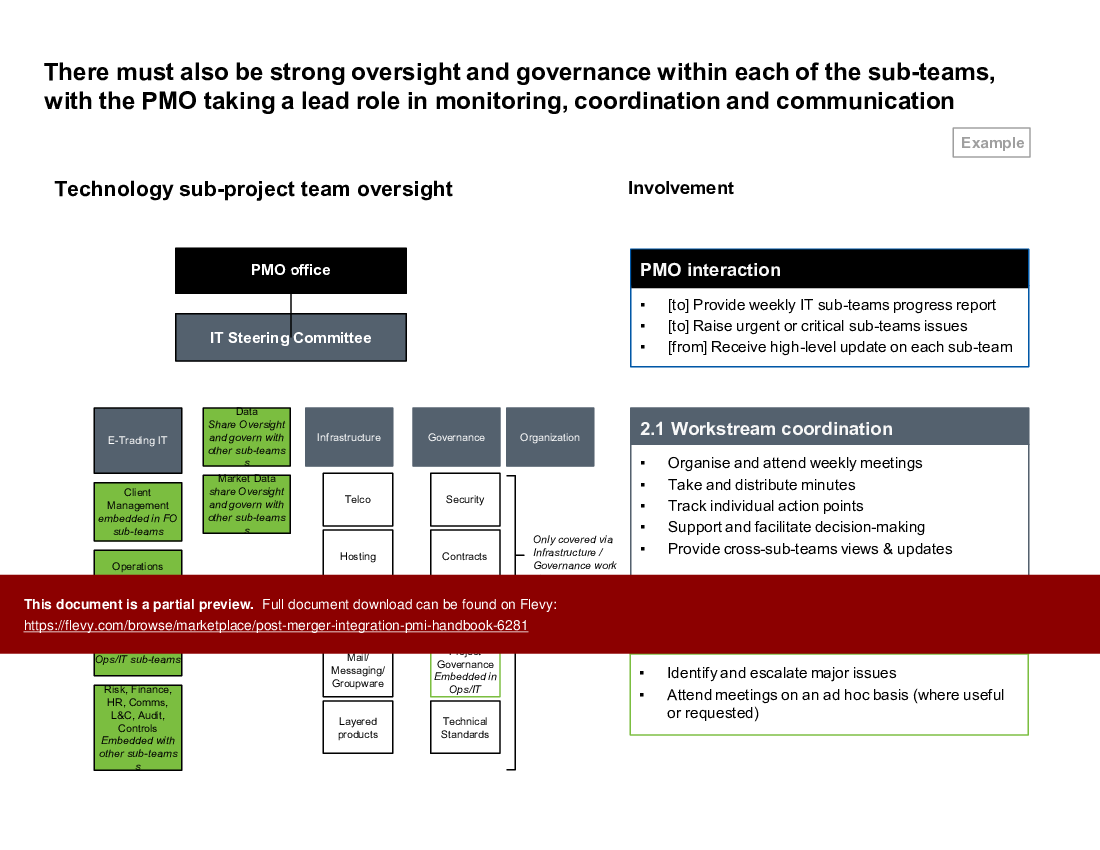
This PPT slide presents a framework titled "The House of Cultural Integration," which outlines essential dimensions for effective cultural integration between merging entities. At the top, the "Organization model" serves as the foundational element, indicating that the overall structure of the organization is pivotal in guiding the integration process.
Four key dimensions are highlighted beneath this model: Governance, Culture & management style, Leadership, and Staff management. Each of these areas plays a critical role in shaping how the organizations will interact and function post-merger. Governance focuses on the decision-making processes and the regulatory frameworks that will guide the new entity. Culture & management style emphasizes the importance of aligning organizational cultures and management approaches to ensure a cohesive working environment.
Leadership is crucial for steering the integration process, as effective leaders can foster collaboration and mitigate resistance among employees. Staff management addresses the human resources aspect, ensuring that talent is effectively managed and integrated into the new organizational structure.
Additionally, the slide includes 2 supporting elements at the bottom: Work council management and Change management and communication. These components suggest that managing employee relations and effectively communicating changes are vital for a smooth transition. The interconnectedness of these dimensions underscores that successful cultural integration requires a holistic approach, where each element influences the others.
Potential customers should recognize that this framework provides a structured way to navigate the complexities of post-merger integration, highlighting the need for careful consideration of organizational culture and management practices.
Framework for Synergy Tools in Post-Merger Integration
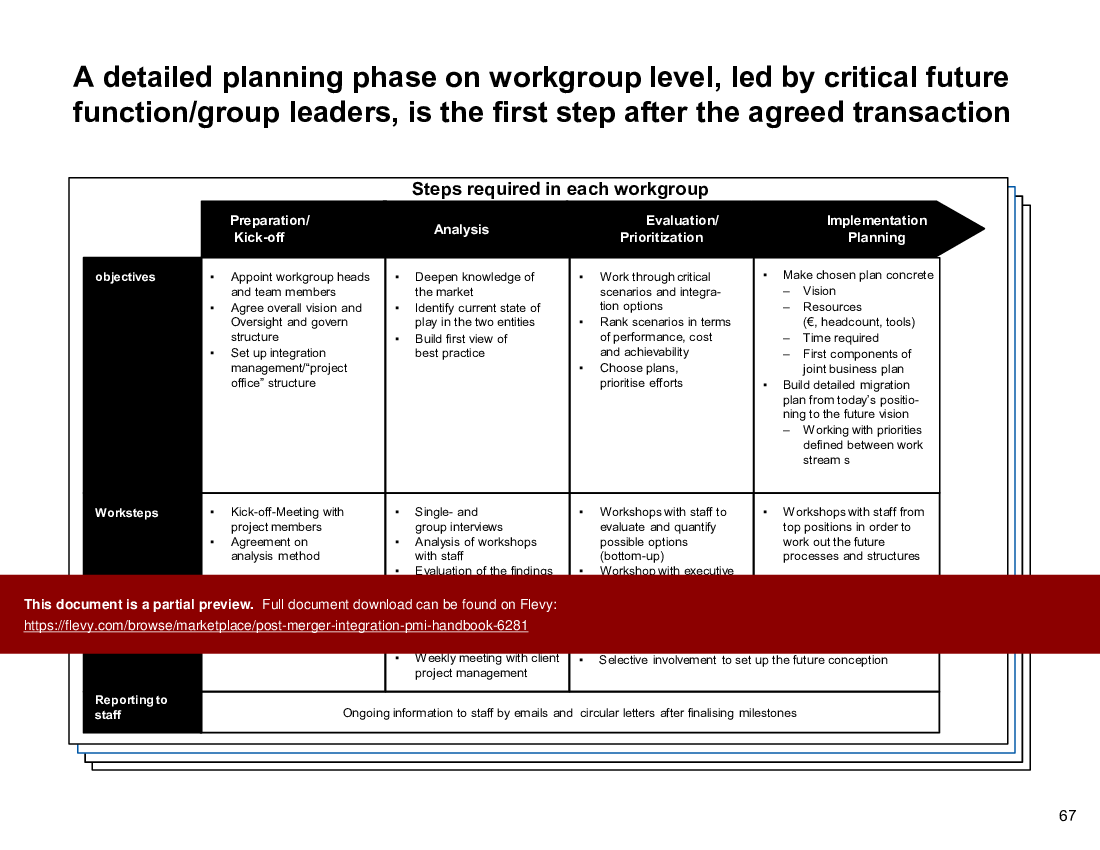
This PPT slide outlines the role of synergy tools in supporting the assessment of revenue and cost synergies during the integration of sub teams following a merger. It emphasizes the importance of these tools in standardizing reporting processes, enabling sub project teams to consolidate their results effectively. The background section highlights that these tools will be utilized for regular monitoring of synergy realization post-legal closing, ensuring that the integration process remains on track.
The process section introduces the "combined company definition programme," which serves as a framework for consolidating savings assessments and planning for realization. This program is designed to facilitate comprehensive analysis by sub teams, with a focus on updating synergy tools and providing critical insights to leadership. The tasks outlined indicate a structured approach to assessing savings and challenging sub team assessments to ensure thorough evaluations.
The consultant's role is also detailed, suggesting that they will support the program management office by updating synergy tools and providing additional analyses related to synergy and restructuring costs. This includes evaluating revenue synergies by product and region, as well as assessing cost synergies and FTE allocations. The slide underscores the collaborative nature of the integration process, where sub teams are expected to provide detailed breakdowns and rationales for their assessments.
Overall, the content is geared towards ensuring that stakeholders understand the systematic approach to synergy realization and the critical role of consultants in facilitating this process. The focus on structured reporting and analysis is essential for effective decision-making and achieving integration goals.
Comprehensive Stakeholder Communication Strategy Post-Merger
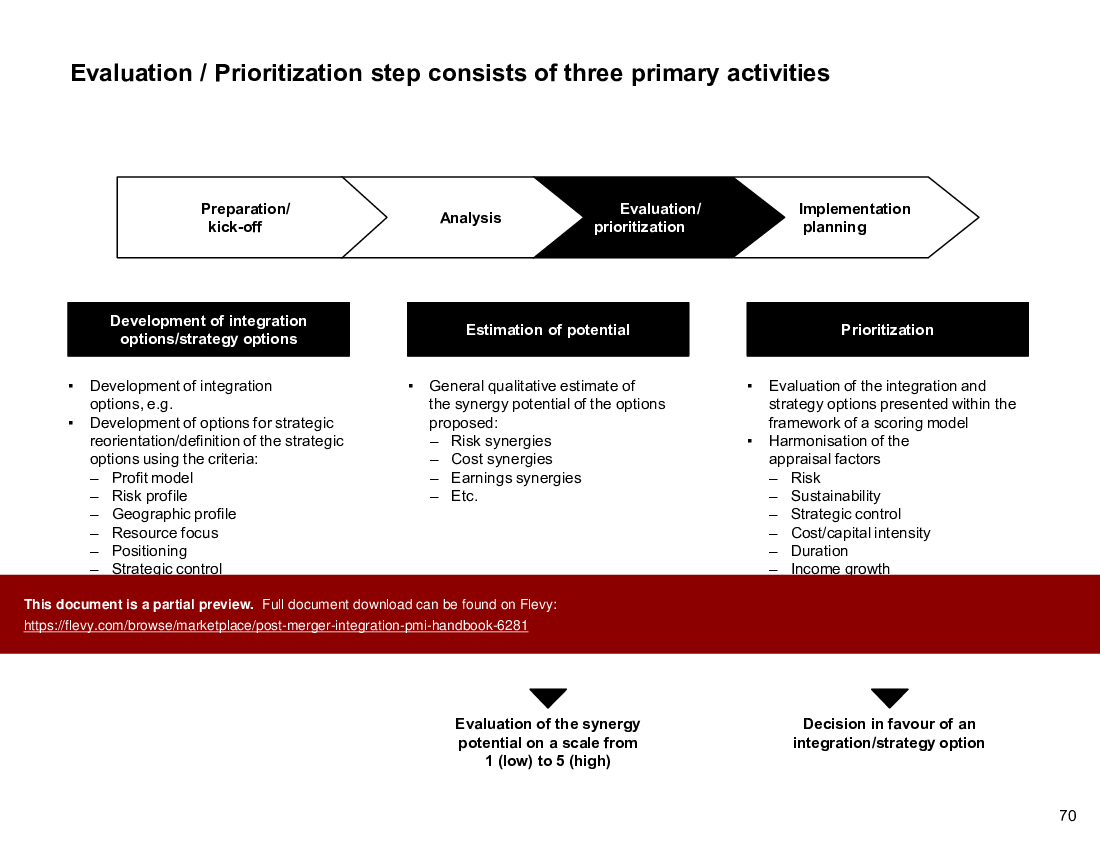
This PPT slide outlines the necessity for comprehensive communication strategies targeting various stakeholder groups during a merger. It emphasizes the importance of addressing both internal and external audiences to ensure alignment and mitigate uncertainties. The diagram in the center illustrates the interconnectedness of different stakeholder categories, including the marketplace, financial community, client team, and other stakeholders.
Each stakeholder group has specific communication objectives. For the marketplace, the focus is on avoiding short-term thinking, highlighting performance and service improvements, and sharing integration plans without revealing sensitive strategic information. The owners' communication objectives center around demonstrating the merger's value, assuring key personnel and customers of their continued involvement, and updating them on integration progress.
Internal communication aims to reduce uncertainty among employees, motivate them, and ensure they have access to necessary information. It also addresses personal and group implications of the merger, influencing desired behaviors to foster a smooth transition. Lastly, communication with other stakeholders, such as government entities and local communities, must comply with regulatory requirements and address specific interests while ensuring consistency in messaging across all groups.
The slide serves as a strategic guide for executives to understand the critical areas of focus in their communication plans, ensuring that all audiences are effectively engaged throughout the merger process. This comprehensive approach is vital for maintaining trust and facilitating a successful integration.
Impact of Transaction Volume on M&A Returns in Banking

This PPT slide presents a correlation between the number of transactions in mergers and acquisitions (M&A) within the banking sector and the resulting return on invested capital (RoIC). It highlights that while many players engage in M&A activities, only a select few, termed "serial acquirers," consistently achieve favorable outcomes. Notable examples include RBS and HSBC, which have honed their post-merger integration (PMI) skills over time.
The scatter plot illustrates a downward trend, suggesting that as the number of transactions increases, the RoIC tends to decline. This indicates that merely increasing transaction volume does not guarantee improved returns. The key takeaways emphasize that success in M&A is not uniform; there are significant disparities in performance among banks that have completed similar numbers of transactions. For instance, comparisons between banks like SocGen KB and Geniki Bank reveal stark differences in their integration effectiveness.
The slide also notes that banks with fewer than 5 transactions exhibit even greater variability in outcomes. The mention of specific cases, such as Credit Agricole's success with Credit Lyonnais versus Fortis's failure with Fortis Turctricial, underscores the importance of effective integration processes. This suggests that the ability to manage and integrate acquisitions is crucial for realizing the full potential of M&A activities.
Overall, the slide serves as a critical reminder for stakeholders in the banking sector to focus on enhancing their integration capabilities rather than simply pursuing a higher volume of transactions. The insights provided here can guide strategic decisions for organizations considering M&A as a growth avenue.
Evolving PMO Roles across Integration Phases
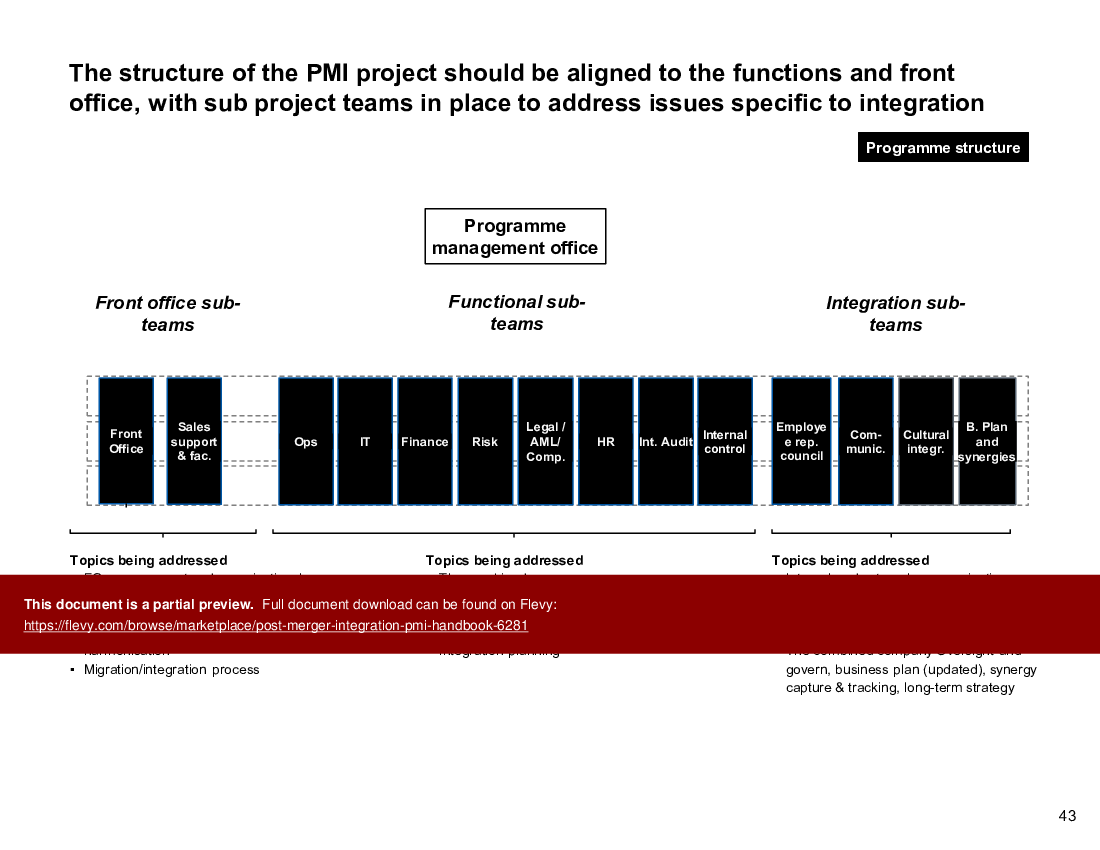
This PPT slide outlines the evolving role of the Project Management Office (PMO) across 3 distinct integration phases. Each phase emphasizes different aspects of the PMO's responsibilities, reflecting a shift in focus as projects progress.
In Phase 1, the core role of the PMO centers on information gathering and analysis. This includes external benchmarking and market observation, which are crucial for understanding the context in which the project operates. The PMO is also tasked with planning programs and sub-projects, laying the groundwork for future phases. Client interaction during this phase involves quantitative data collection and interviews with key stakeholders, ensuring that the PMO has a comprehensive view of the project's landscape. The emphasis on steering committee oversight highlights the PMO's role in guiding decision-making processes.
Phase 2 marks a transition to more defined project management activities. The PMO's core role shifts to defining the business plan and target operating model, along with comprehensive program planning. Ongoing program management becomes a priority, indicating a more hands-on approach. Client interaction evolves to include regular reviews with business leaders, fostering collaboration and timely decision-making. Joint-staffed working groups are introduced, facilitating deeper engagement on critical topics.
By Phase 3, the PMO's role is fully integrated into the operational fabric of the project. Responsibilities include coordination, monitoring, and management of working groups, as well as problem resolution. Communication becomes vital, with a focus on both upward and downward communication channels. Change management and cultural integration issues are also addressed, reflecting the complexities of merging organizations. Tools and processes are refined to enhance transparency and decision-making, ensuring that the PMO remains a pivotal force throughout the integration journey.
Roles and Responsibilities in Post-Merger Integration
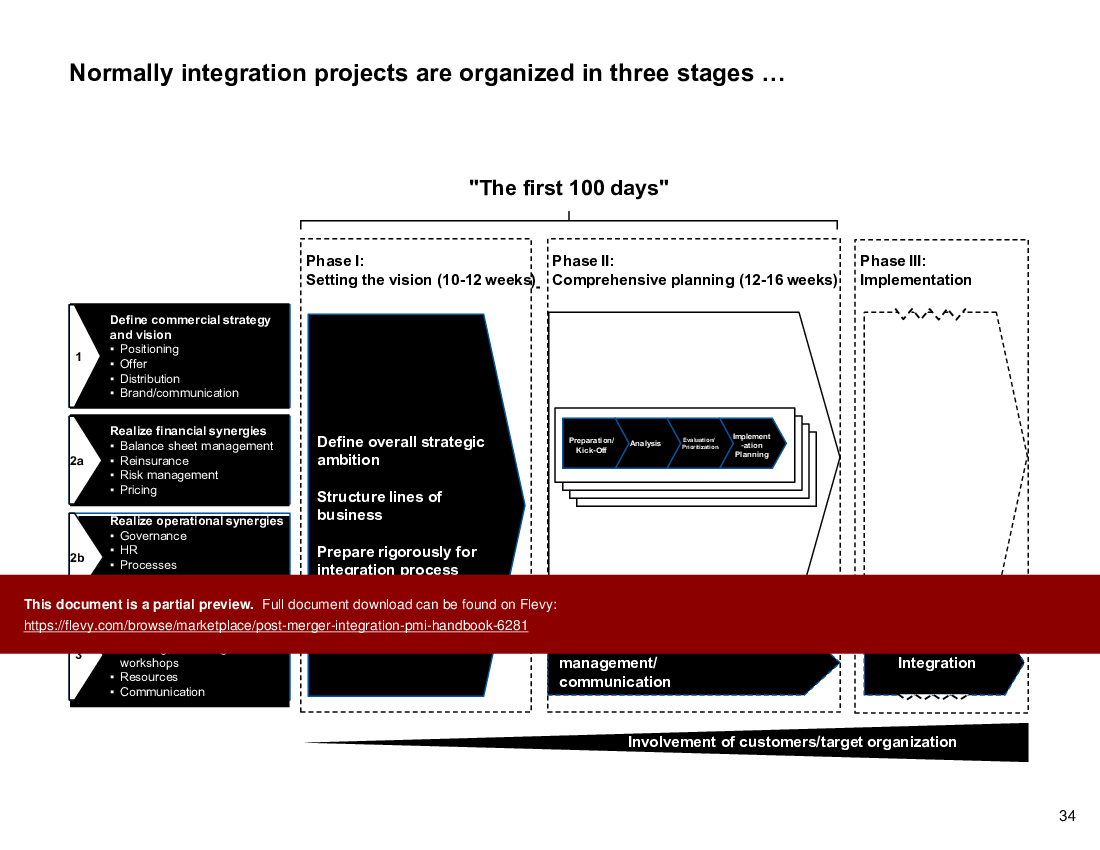
This PPT slide outlines the roles and responsibilities of executive sponsors and leaders in managing sub-teams during a post-merger integration phase. It emphasizes that executive sponsors hold ultimate accountability for the success or failure of their respective sub-teams. This includes ownership towards the board regarding the integration process and deliverables.
Key components of the sub-team's charter are detailed, highlighting the scope, critical tasks, and deliverables necessary for the combined company from Day 1 after closing. The slide stresses the importance of aligning these deliverables with the strategic and operational model of the newly formed organization.
Resource allocation is another critical area, where the slide notes that contributions should come from existing teams within both organizations. It also mentions the need for alternative staffing solutions if specific requirements arise. Decision-making processes are outlined, indicating that issues may need to be escalated to a steering committee when necessary.
Validation of deliverables is crucial, as these must be presented to the steering committee to ensure alignment with the overall integration strategy. The realization of synergies is also highlighted, indicating that these should be planned and agreed upon within the sub-team's scope.
Leaders are tasked with day-to-day management of sub-teams, ensuring that work streams are validated and bottlenecks are addressed promptly. Interaction with other teams is necessary to facilitate decision-making and support the integration process. Overall, the slide provides a structured approach to managing the complexities of post-merger integration, emphasizing accountability, resource management, and effective communication.
Identifying Key Risks in Post-Merger Integration

This PPT slide outlines various typical risks associated with post-merger integration, categorized by reference number, risk description, potential impact, and likelihood.
The first risk, "Work Council constraints," highlights challenges with unions not accepting new terms and conditions, particularly regarding redundancy packages. This could lead to strikes, damaging revenues and customer confidence, and ultimately hinder the realization of merger synergies.
Next, "Financial risks" are noted, emphasizing the reduced focus on risk monitoring during transition phases. Operational risks can arise from migrating processes and client accounts, where errors could significantly damage credibility with large customers. The impact of these financial risks is hard to predict, but could result in substantial losses if not managed effectively.
The slide also addresses "Technology costs and platform stability." Poor assessment of implementation costs and inadequate decision-making regarding platform architecture can lead to spiraling tech costs. If the chosen platform fails to support business needs or is delayed, customers may seek alternative providers.
"Public Perception" is another critical risk. An unfavorable public image, exacerbated by inaccurate press coverage, can lead to customer attrition as businesses may distance themselves from perceived internal conflicts.
Finally, "Loss of growth momentum" is discussed, where differing views on growth opportunities can create confusion about the merger's rationale. This can disrupt performance and hinder the ability to meet business targets.
Overall, the slide serves as a cautionary overview for executives to consider the multifaceted risks that can arise during post-merger integration, emphasizing the need for careful planning and management.
Standardized Planning Tool for Phase 2

This PPT slide outlines a planning tool designed to standardize the structure for documenting the tasks associated with phase 2 of a project. It emphasizes several key objectives aimed at enhancing project management efficiency.
First, it aims to provide a uniform format for subteams to record their tasks, ensuring consistency across the board. This standardization is crucial for facilitating the development of sub-team work plans. Once these plans are validated and submitted, they will be utilized by the Programme Management Office to track the progress of various sub-teams. This oversight is vital for maintaining alignment and ensuring that all teams are on the same page.
The slide also highlights the importance of clear ownership for each deliverable. This clarity helps to avoid confusion and ensures accountability within the teams. Furthermore, it stresses adherence to a defined planning hierarchy, which includes sub-team, workstream, deliverable, and task levels. This structured approach ensures that there are clear connections between tasks and their respective deliverables, which can enhance overall project coherence.
The visual representation on the right illustrates the structure of sub-project teams, breaking down workstreams and deliverables into manageable tasks. This hierarchical view aids in understanding how different components of the project interrelate, making it easier for stakeholders to grasp the project's scope and progress.
Overall, the slide serves as a foundational guide for implementing a structured planning approach, which can significantly improve project execution and monitoring.
Executive Workshop Deliverables for Integration
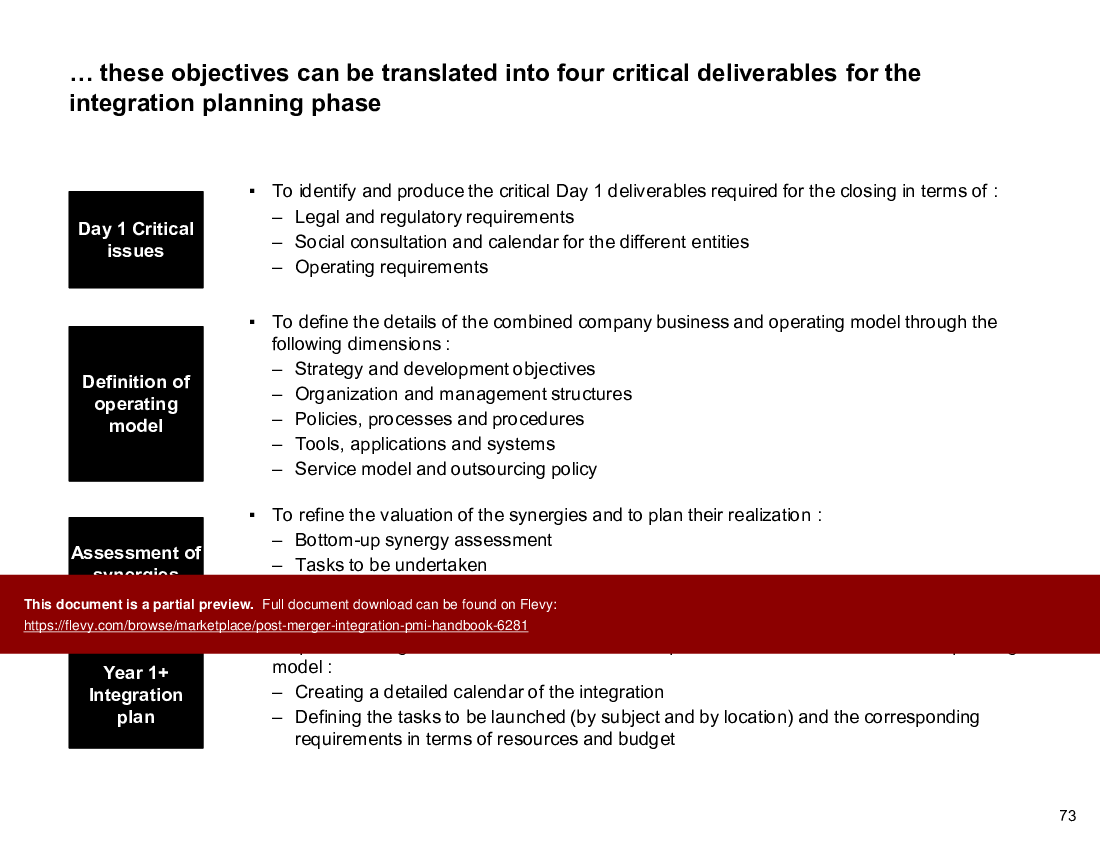
This PPT slide outlines the deliverables from an executive workshop designed to guide the pace and critical milestones of a project. It is structured into 5 distinct workstreams (WS1 to WS5), each detailing specific deliverables that contribute to the overall integration plan.
In WS1, the focus is on foundational activities. Key deliverables include setting up sub-teams, agreeing on team charters, defining the work plan, and identifying critical processes for Day 1. This initial phase is crucial for establishing a clear direction and ensuring that all team members are aligned.
WS2 shifts towards more detailed planning. Here, the deliverables include a description of the target structure, the first draft of the integration plan and budget, and a list of Day 1 critical processes. Additionally, it emphasizes bottom-up synergy calculations, which are essential for understanding potential benefits and efficiencies.
WS3 builds on the previous work by requiring a comprehensive target structure to be signed off. It also includes a more refined draft of the integration plan and budget, along with a review of Day 1 critical processes. This phase is about ensuring that the groundwork laid in earlier stages is validated and ready for implementation.
In WS4, the focus is on finalizing deliverables for validation. This includes updated synergies and a review of the bottom-up reconciliation with top-down targets. It is about ensuring that all elements are aligned and ready for execution.
Finally, WS5 centers on execution. Key deliverables here include finalized synergy calculations, implementation of Day 1 critical processes, and a detailed integration plan. This phase is where strategic planning translates into actionable steps, ensuring that the project is set for success.
Integration Process Types: Timing and Management Perspectives

This PPT slide outlines 4 distinct types of integration processes that can be categorized based on the timing of the transaction and the management's perspective. Each type reflects varying degrees of openness and readiness to integrate following a transaction.
The first category, "Let's do it," emphasizes immediate action. Here, the integration process kicks off right after signing, allowing for an open exchange of information from day one. Critical issues can be discussed and resolved before formal closing, indicating a proactive approach to integration.
"Slowly, Slowly" represents a more cautious strategy. While integration planning can commence, there is a significant time lag between signing and closing, which restricts the exchange of sensitive competitive information. Although some directional guidelines can be established, decision-making is hindered, leading to potential delays in the integration process.
The "Pax Romana" approach also requires immediate action, but involves a more structured pre-integration phase. This phase is crucial for establishing a mutual understanding of future directions and business guidelines. Leadership plays a critical role here, as decisive actions are necessary to guide the integration.
Lastly, the "Suspicion" category reflects a defensive stance. Integration planning is largely avoided, with a focus on making plans for the initial day based on rigid guidelines. This approach aims to minimize disruptions and stabilize the business, addressing any insecurities that may arise from the transaction.
Understanding these integration types can help organizations tailor their strategies based on their specific circumstances and management styles, ultimately influencing the success of the integration process.
Structured Approach to Integration Projects
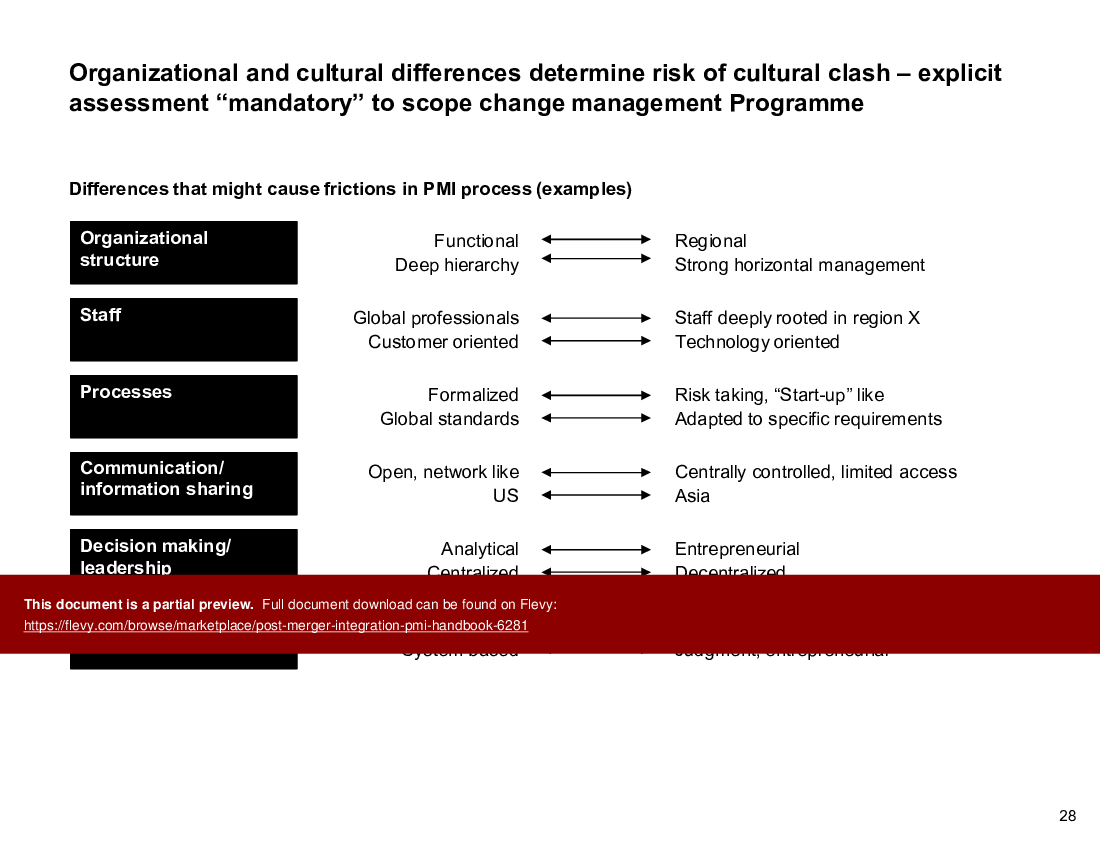
This PPT slide outlines a structured approach to integration projects, emphasizing a three-phase process. The first phase, titled "Setting the vision," spans 10 to 12 weeks. It focuses on defining the overall strategic ambition, structuring lines of business, and rigorously preparing for the integration process. Key tasks include defining the commercial strategy and vision, which encompasses positioning, offer, distribution, and brand communication.
The second phase, "Comprehensive planning," lasts 12 to 16 weeks. This phase involves detailed preparation and analysis, including a kickoff, analysis, and the development of a comprehensive implementation plan. It highlights the importance of realizing financial and operational synergies. Financial aspects include balance sheet management, reinsurance, risk management, and pricing. Operational synergies cover governance, human resources, processes, information services, and purchasing.
The final phase, simply labeled "Implementation," is where the plans developed in the earlier phases are put into action. This phase is crucial for ensuring that the integration is executed effectively and that the intended synergies are realized.
The slide also emphasizes the need for program management and communication throughout the integration process, indicating that clear communication and structured management are essential for success.
Overall, this slide serves as a roadmap for organizations looking to navigate the complexities of integration projects, providing a clear timeline and key focus areas to ensure a successful outcome.
Structured Analysis Framework for Post-Merger Integration

This PPT slide outlines a structured approach to the analysis phase of a post-merger integration process, detailing 4 sequential activities. It begins with the "Preparation/kick-off" phase, which sets the stage for the subsequent analysis. The core of the slide is divided into 2 main components: "Analysis of structures and processes" and "Strategic analysis."
The first component emphasizes the importance of understanding the operational organization and the organizational structure of both merging entities. This involves conducting interviews and reviewing internal documents to gather insights. Key areas of focus include operational organization—covering systems, interfaces, process frequencies, and quality standards—as well as the organizational structure, which looks at capacity, skills, and competencies. The goal is to identify strengths and weaknesses, which will inform the integration strategy.
The second component, "Strategic analysis," shifts focus to market dynamics. It highlights the necessity of analyzing market developments from both customer and competitor perspectives. This includes a sales analysis and assessing risk-return positioning. Additionally, the analysis aims to explore potential leveraging opportunities through benchmarking, specifically regarding earnings and savings potential.
The slide concludes with a visual representation of the flow from identifying common features and differences between the 2 institutions to determining the market environment. This structured approach ensures a comprehensive understanding of both internal capabilities and external market conditions, which is crucial for effective integration planning.
Finance Integration: Deliverables and Risks Overview
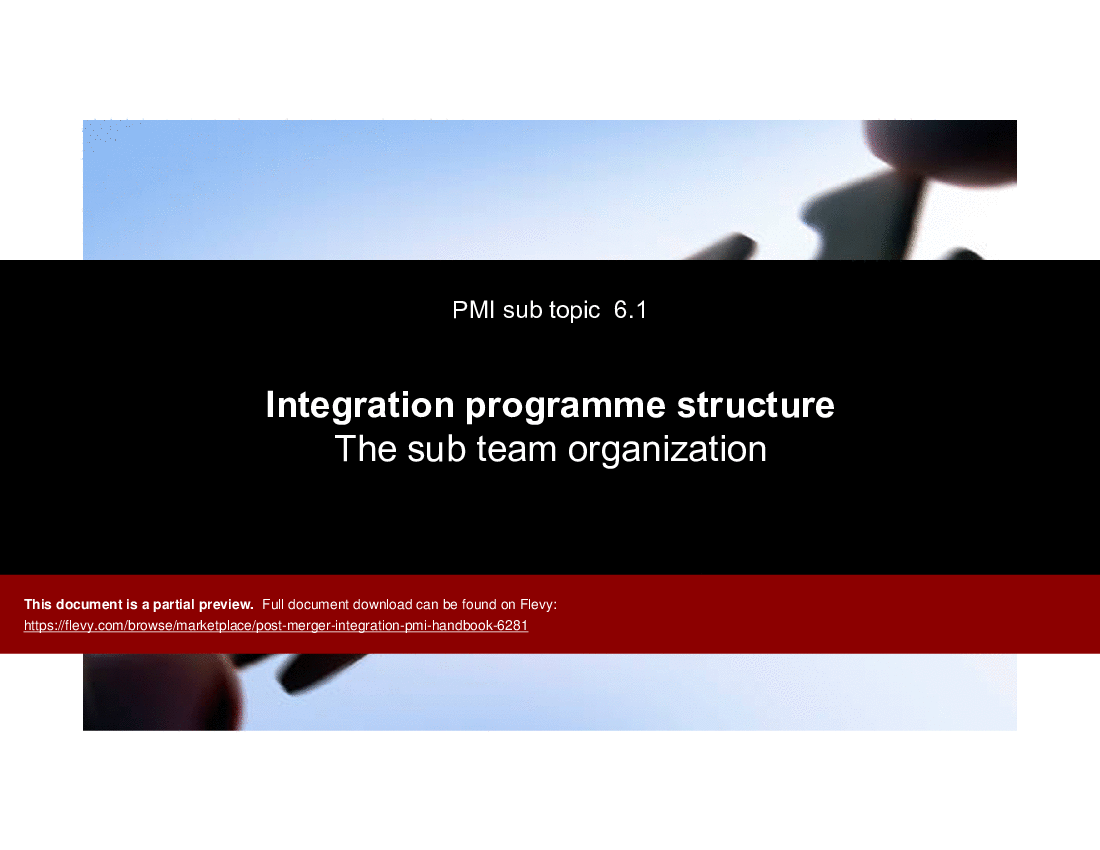
This PPT slide outlines critical deliverables and potential risks associated with the Finance Sub project teams during a merger or acquisition. It emphasizes the importance of establishing a clear finance structure, which includes defining the finance "charter" and scope, as well as detailing the target organization at various levels—global, regional, and local. The slide highlights the need for comprehensive job descriptions for key finance roles such as controllers, financial analysts, and accountants, ensuring clarity in responsibilities within the newly combined entity.
Documentation of finance processes is also crucial, particularly for global and regional consolidation. This involves assessing the technological requirements to support the finance team and selecting appropriate platforms for management and accounting systems. Planning for the integration effort is emphasized, focusing on teams, systems, and processes.
Next year's budgets are mentioned, indicating a need for pro-forma integration that considers both integration costs and potential synergies. The slide also addresses the importance of aligning finance policies across the merged entities, including capital requirements and target cash management strategies.
On the right side, critical risks are identified. These include the necessity to comply with country-specific reporting requirements and the timing of budget approvals from shareholders. There’s also a mention of creating new activities from scratch in certain locations, which may have previously been outsourced. This highlights the complexities involved in merging finance functions and the potential pitfalls that need to be navigated carefully.
Comprehensive Overview of Transaction Lifecycle Stages

This PPT slide outlines the transaction lifecycle, emphasizing the importance of obtaining expert advice at each stage. It is divided into distinct phases: Idea Generation, Sourcing, Analysis/Due Diligence/Decision Making, Structure and Execution, Post Merger Integration (PMI), Post Acquisition & Portfolio Value Enhancement, and Exit/Portfolio Management.
In the Idea Generation phase, key activities include industry and sector selection, observing industry evolution, and identifying emerging ideas. This stage sets the foundation for future transactions by screening potential acquisitions and understanding value migration and growth opportunities.
Sourcing focuses on proactively identifying opportunities. This involves networking and introductions to relevant parties, which is crucial for uncovering potential deals.
The Analysis phase includes competitor analysis and stakeholder assessment, alongside evaluating business models and profitability. Due diligence is highlighted as a critical step to ensure informed decision-making.
Structure and Execution encompass the practical aspects of deal-making. This includes program management, developing strategies and business models, and integrating IT and operations processes.
Post Merger Integration is vital for realizing synergies and ensuring that the merger or acquisition achieves its intended goals. This phase emphasizes the importance of managing organizational models and measuring performance.
The slide also discusses Post Acquisition & Portfolio Value Enhancement, which focuses on turnaround strategies and identifying new value propositions. Finally, Exit/Portfolio Management involves finding strategic buyers and articulating the rationale behind the transaction.
Overall, the slide serves as a comprehensive guide for executives considering the complexities of transactions, highlighting the necessity of expert advice throughout the lifecycle.
Framework for Post-Merger Integration and Value Creation
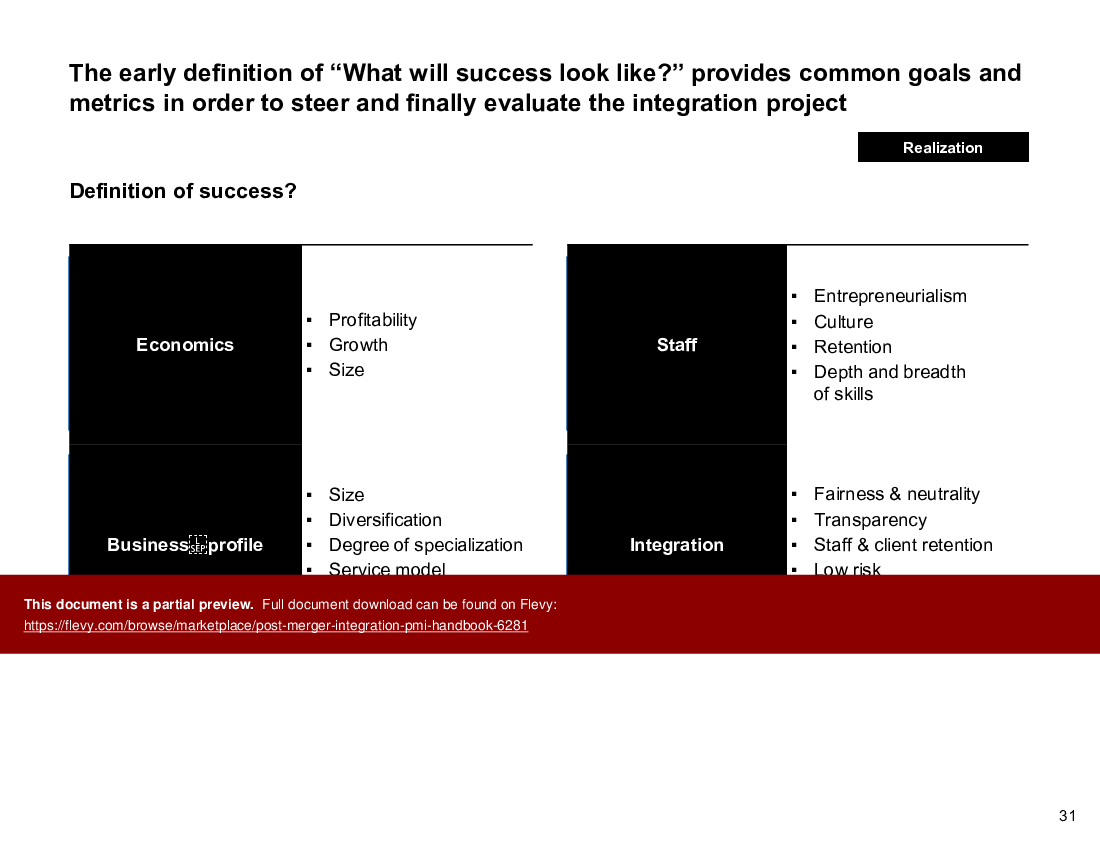
This PPT slide outlines a structured approach to value creation across various organizational levels, emphasizing the critical roles of project management and effective communication. It is divided into 2 main sections: "Achieve operational targets" and "Create one company." Each section details specific objectives and initiatives that can be implemented to drive integration and efficiency post-merger.
In the "Achieve operational targets" section, key activities are highlighted. Setting goals and creating an integration framework are foundational steps that establish direction and clarity. Optimizing resources and efficiency is crucial for maximizing output, while developing a joint go-to-market mechanism ensures that the newly formed entity can effectively penetrate markets. Reducing overlaps and integrating programs are also vital to streamline operations and eliminate redundancies, thereby enhancing overall performance.
The "Create one company" section focuses on cultural and strategic alignment. Implementing a global vision and strategy is essential for unifying the organization under a common purpose. Creating a shared organizational culture fosters collaboration and cohesion among diverse teams. Managing change effectively is highlighted as a necessary skill to navigate the complexities of integration.
Overall, the slide serves as a roadmap for executives looking to facilitate a smooth transition during post-merger integration. It emphasizes the importance of aligning operational goals with cultural integration, ensuring that all levels of the organization are engaged in the process. This comprehensive approach not only supports immediate operational needs, but also lays the groundwork for long-term success.
Integration Programme: Roadmap for Successful Mergers
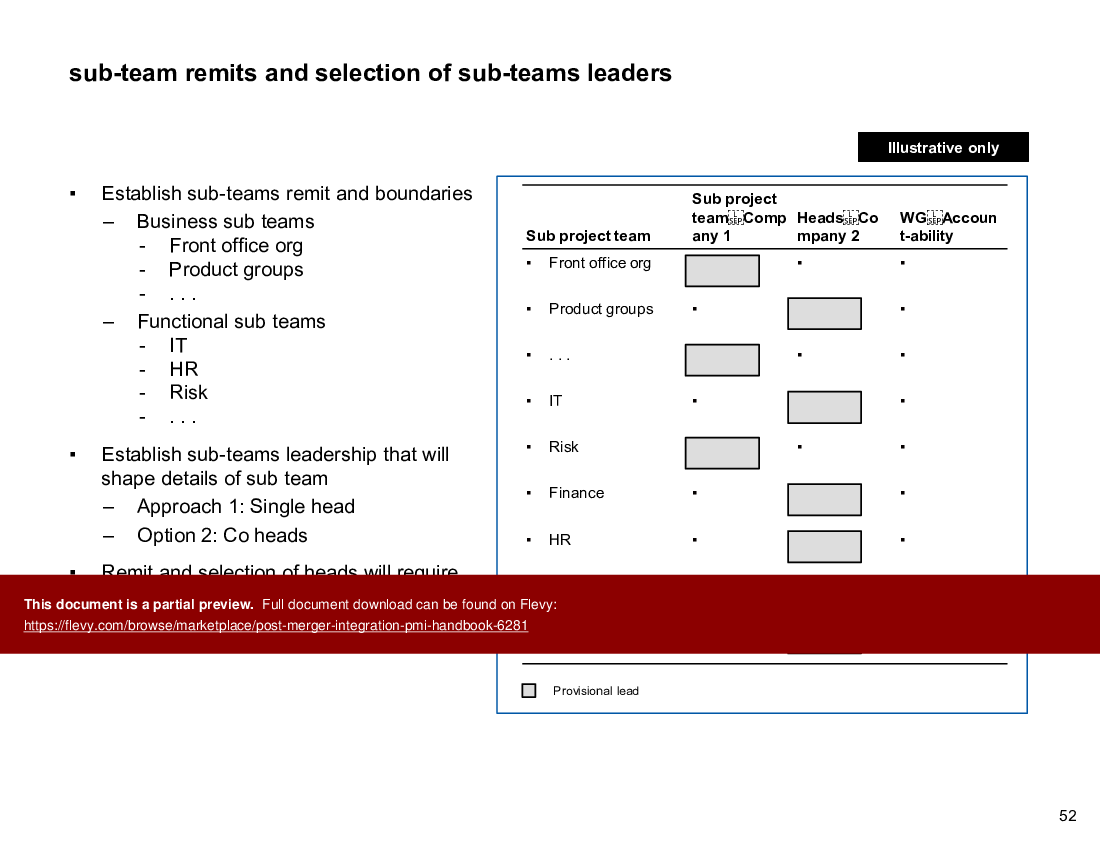
This PPT slide outlines the essential components of the "Integration Programme" critical projects and detailed objectives, which are crucial at the conclusion of phase one of a merger or acquisition. It emphasizes the need for a clear and detailed roadmap tailored to specific business functions.
The first section, labeled "Consolidated," highlights the connections between the overarching objectives of the Group and the specific goals of various businesses and functions. This suggests a focus on aligning priorities across the organization, ensuring that all units are working towards common objectives.
Next, the "Exhaustive" section indicates the necessity of formalizing the entire integration plan. This involves detailing each project, along with strategic and organizational choices, and prioritizing actions. This structured approach is vital for maintaining clarity and focus throughout the integration process.
The "Changing" section addresses the dynamic nature of integration, emphasizing the importance of updating actions based on actual progress and critical trade-offs. This suggests that flexibility and adaptability are key to navigating the complexities of integration.
Finally, the "Binding" section underscores the collaborative effort required to produce the integration plan. It involves business heads and project managers working together, ensuring that all stakeholders are committed to meeting the defined objectives. This collective responsibility is essential for driving successful outcomes in the integration process.
Overall, the slide serves as a strategic framework for managing integration effectively, highlighting the need for alignment, detailed planning, adaptability, and collaboration among all parties involved.
Key Factors for Successful Post Merger Integration

This PPT slide outlines critical success factors for Post Merger Integration (PMI) programs, juxtaposed against common failure areas. It emphasizes the importance of a structured approach to integration, highlighting 3 main areas: business logic, pricing strategies, and integration planning.
In the first section, the slide identifies a failure to establish a robust business rationale as a key risk. It suggests that organizations must apply a consistent strategic framework. This involves creating a joint vision, defining objectives, and aligning business targets with organizational requirements from the outset. The emphasis is on clarity and shared goals to guide the integration process effectively.
The second area addresses financial considerations, particularly the risks associated with overpaying for acquisitions. The critical success factor here is to make synergies tangible. Organizations should focus on realizing financial, operational, and cultural synergies by sharing best practices and integrating processes. This approach aims to ensure that the anticipated benefits of the acquisition are not only theoretical, but also practically achievable.
Lastly, the slide discusses integration planning and execution, noting that poor planning often leads to integration failures. The recommended success factor is to actively manage and communicate the integration program. This includes planning the stages of integration, maintaining clear communication, and managing change effectively. The slide suggests that early planning and a structured approach can mitigate risks and enhance the likelihood of a successful integration.
Overall, the content provides a clear framework for organizations to navigate the complexities of PMI, focusing on strategic alignment, realization of synergies, and effective change management to drive successful outcomes.
Key Success Factors for Effective Integration Process

This PPT slide outlines critical success factors for an effective integration process, specifically focusing on Post Merger Integration (PMI). It emphasizes the importance of a seamless transition from the transaction phase to integration, highlighting 4 key areas: the integrative process, preparation for the transaction, negotiation, and the PMI itself.
The integrative process stresses the need for a continuous and comprehensive approach. It suggests avoiding fragmentation between preparation, transaction, and PMI phases. This holistic view is crucial for ensuring that all elements of the integration are aligned and work together efficiently.
Preparation for the transaction involves establishing a strategic fit and direction before due diligence. This includes defining the strategic cornerstones of the business model, such as distribution, products, and organization. Initial estimations of potential synergies are also highlighted, indicating the need for foresight in identifying value creation opportunities.
The negotiation phase focuses on both quantitative and qualitative due diligence. It underscores the importance of assessing the valuation and risk profile of the transaction while also considering softer factors like organizational culture and human resources. This dual approach ensures a more rounded evaluation of the transaction's implications.
Finally, the PMI section outlines the need for an efficient process post-transaction. Clear definitions of objectives and integration models are vital. Proactive preparation during the transaction and identifying critical issues for PMI are essential steps. Customizing communication strategies before, during, and after the transaction is also recommended to facilitate smoother integration. Overall, the slide serves as a guide for organizations aiming to enhance their integration processes effectively.
Weekly Issue Log Submission Framework
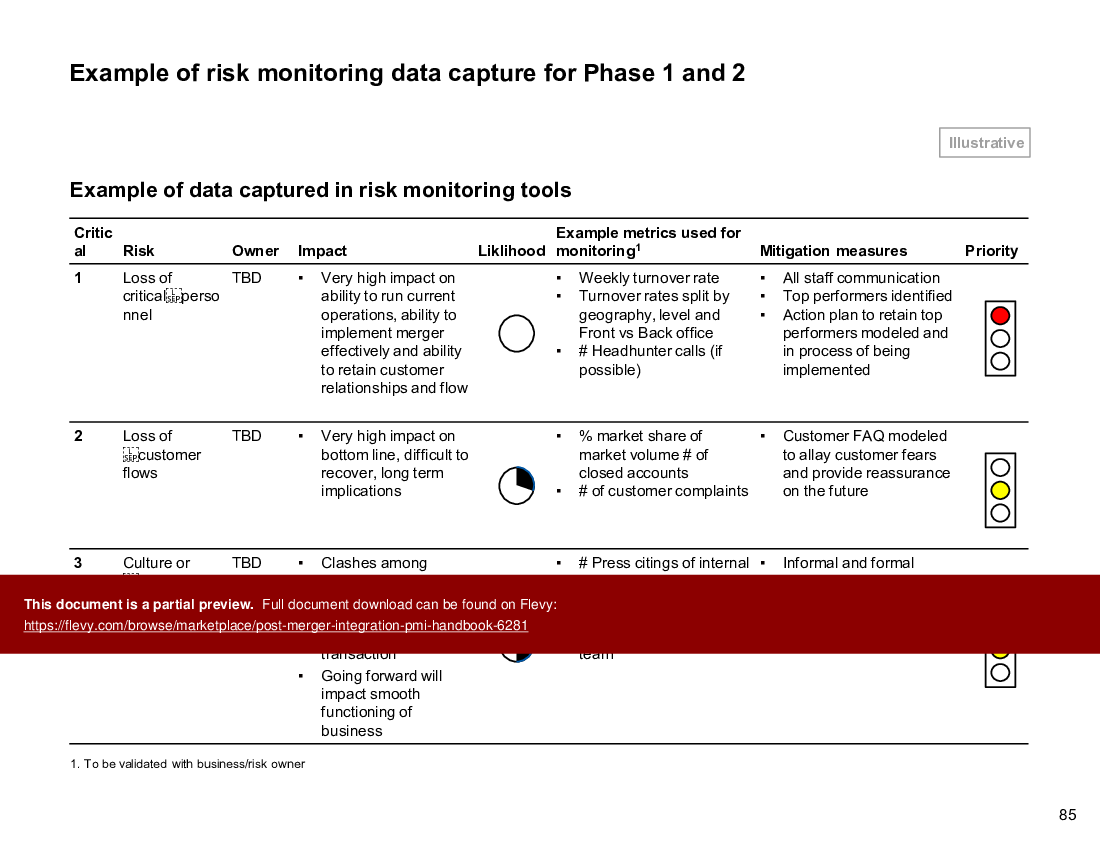
This PPT slide emphasizes the importance of weekly issue log submissions by sub-teams to ensure effective tracking of critical issues within a program management framework. The left side outlines the tool objectives, which serve as a guide for sub-teams in their reporting process. Each objective highlights a key aspect of the issue tracking system.
The first objective focuses on providing templates for sub-teams to report their issues' status. This standardization is crucial for maintaining clarity and consistency across the board. The second objective stresses the need for consolidating information, which allows the program management office to have a comprehensive view of all reported issues. This consolidation is vital for informed decision-making and prioritization.
Standardization is further emphasized in the third objective, which aims to ensure that all sub-teams are monitored uniformly. This uniformity can lead to more efficient management of resources and quicker resolution of issues. The final objective addresses the necessity of tracking outstanding, in-progress, and resolved issues, along with their proposed solutions and assigned owners. This level of detail is essential for accountability and follow-up.
The right side of the slide presents an example tool, likely a template or spreadsheet, designed to facilitate this process. The visual representation suggests a structured approach to logging issues, with color coding that may indicate the status of each issue. This tool not only aids in tracking, but also serves as a communication mechanism among teams and the program management office. Overall, the slide conveys a systematic approach to issue management, which is critical for the success of any program.
Psychological Impact of Early Integration Planning

This PPT slide emphasizes the importance of initiating the integration planning process early following a merger or acquisition. It presents a graphical representation of the relationship between the timing of planning and the psychological impact on the involved teams. The x-axis indicates the degree of planning, while the y-axis reflects the degree of passion among team members.
An early kick-off is shown to correlate positively with heightened passion levels. This suggests that when integration planning begins promptly, it can foster enthusiasm and commitment among employees. The slide notes that early progress not only boosts morale, but also helps to limit the duration of layoffs, providing a sense of security for remaining staff.
The text highlights the need to harness the initial passion and willingness to adapt that often accompanies the closing of a transaction. This energy can be directed towards implementing critical projects, which may include difficult decisions like layoffs. The visual cue of an upward arrow reinforces the idea that timely planning can lead to improved outcomes, both psychologically and operationally.
Overall, the slide serves as a reminder that the timing of integration planning is crucial. It underscores that proactive measures can mitigate potential negative impacts on employee morale and engagement, ultimately leading to a smoother transition and more effective integration process. This insight is particularly valuable for executives looking to navigate the complexities of mergers and acquisitions with a focus on human capital.
Governance Framework for Technology Sub-Project Oversight
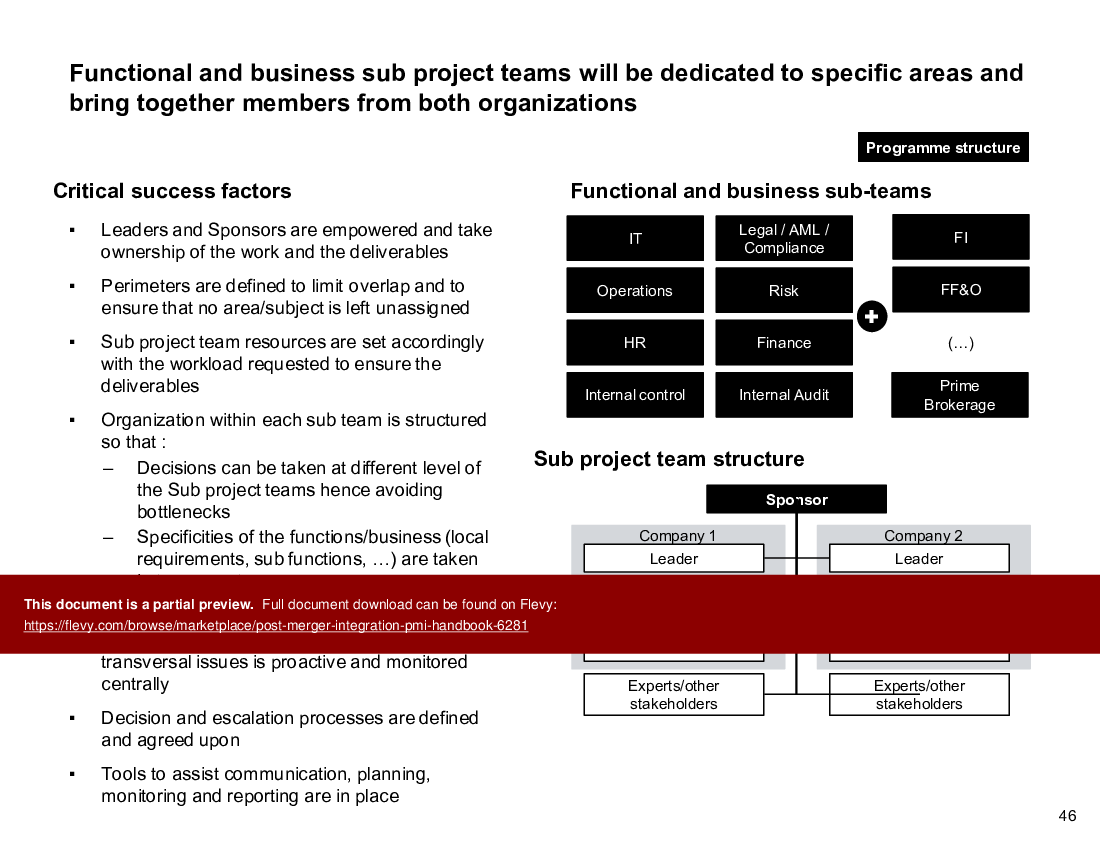
This PPT slide outlines a framework for effective oversight and governance within technology sub-project teams, emphasizing the role of the PMO (Project Management Office) in monitoring and coordinating activities. It highlights the structure of governance, indicating that the PMO office collaborates closely with the IT Steering Committee to ensure alignment across various sub-teams.
The left section details specific sub-project teams, such as E-Trading IT and Infrastructure, and their respective responsibilities. Each sub-team is tasked with sharing oversight and governance with others, which fosters a collaborative environment. For instance, the E-Trading IT team integrates client management and operations into its sub-teams, ensuring that all aspects of trading technology are covered comprehensively.
The right section focuses on PMO interactions, which are crucial for maintaining communication and transparency. It specifies that the PMO is responsible for providing weekly progress reports from IT sub-teams, raising urgent issues, and receiving high-level updates. This structured communication flow is vital for timely decision-making and issue resolution.
Further down, the slide introduces workstream coordination, detailing essential tasks such as organizing weekly meetings, distributing minutes, and tracking action points. These activities are designed to support decision-making and ensure that all sub-teams remain aligned with overall project goals.
The final point addresses the aggregation of workstream issues, emphasizing the need to identify and escalate major concerns promptly. This proactive approach helps mitigate risks and ensures that the project remains on track. Overall, the slide serves as a guide for establishing a robust governance framework that enhances collaboration and accountability within technology projects.
Financial Impact of Losing Key Sales Personnel
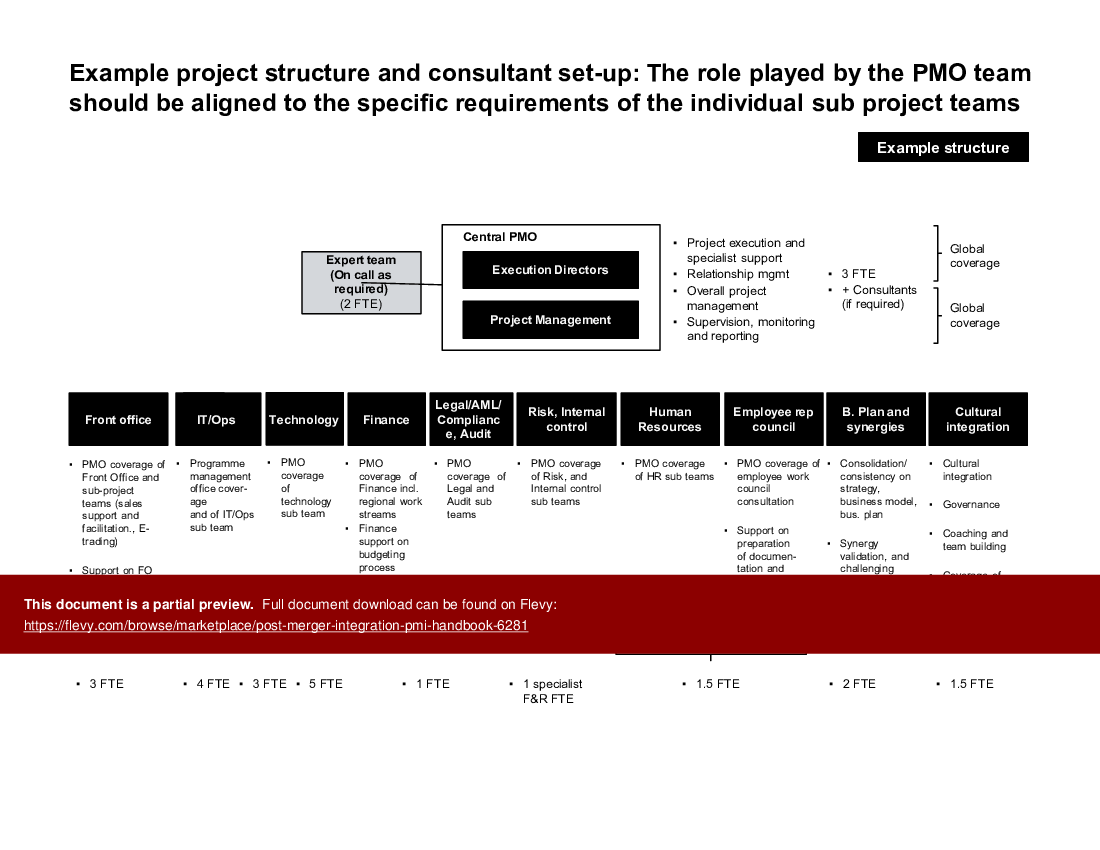
This PPT slide highlights the significant financial implications of losing key sales personnel, particularly in the context of a merger. It begins with a clear assertion that the departure of top producers directly impacts revenues, primarily through the loss of client relationships and the potential for ongoing business disruption. The visual representation indicates a direct loss in revenues, emphasizing the urgency of addressing this issue.
Retention strategies are discussed as critical to mitigating a "sales dip" that often follows mergers. The slide notes that isolated efforts to retain top talent, such as substantial salary increases, may not be sufficient. For instance, it mentions an 80% salary increase offered to retain a specialized salesperson, suggesting that such measures are reactive rather than proactive.
The slide also points to the competitive environment, where high-profile sales teams are at risk of poaching by competitors. It references a specific example of a company that can attract talent due to a forthcoming IPO, contrasting it with another company facing uncertainty. This highlights the need for a robust retention strategy in a volatile market.
Finally, the slide suggests that any retention mechanisms should be strategically linked to sales targets, with staggered payments to incentivize performance over time. This approach indicates a shift from one-time bonuses to a more structured, performance-based retention strategy. Overall, the content underscores the importance of proactive measures in talent retention to safeguard revenue streams during critical transitional periods.
Strategic Synergies for Value Creation Post-Merger

This PPT slide emphasizes the critical role of synergies in driving value creation, focusing on both operational and cultural elements. It is structured into 2 main branches under the central theme of "Value creation." The left branch, titled "Achieve operational targets," outlines 3 key components: financial synergies, optimal organization and structure, and world-class processes. Each of these elements is essential for ensuring that the operational side of the business is aligned and efficient, which is crucial for achieving the overall goals of the organization.
On the right side, the slide highlights the importance of creating a unified company culture. This section includes 3 points: "One firm, one look," which suggests a cohesive brand identity; "One global strategy: Vision-values-mission," indicating the need for a shared strategic direction; and "Common and combined culture," which stresses the significance of integrating diverse cultural elements post-merger.
At the bottom of the slide, there is a mention of "Synergy realization progress and monitoring of status," indicating that tracking and assessing the effectiveness of these synergies is vital for ongoing success. This suggests a structured approach to ensure that both operational and cultural synergies are not only established, but also maintained over time.
Overall, the slide serves as a strategic framework for executives looking to navigate the complexities of post-merger integration, ensuring that both operational efficiencies and cultural alignment are prioritized for sustainable value creation.
Framework for Post-Merger Integration Management

This PPT slide outlines a structured framework for managing and monitoring work streams in a post-merger integration context. At the top level, it indicates an overall high-level view, managed by a Programme Manager, who oversees integrated information from all work streams. This sets the tone for a comprehensive approach to project management.
The framework is divided into several key areas: IT and Operations, Management and Control, Data and Reporting, and Operations. Each area has designated owners responsible for specific tasks, ensuring accountability and clarity in roles. The Programme Manager oversees the overall integration, while work group leads and work stream managers handle more granular aspects.
Within the IT and Operations section, there are 2 distinct layers: one for overall integration and another for comprehensive sub-projects. This dual approach allows for both a broad overview and detailed attention to specific initiatives. The Management and Control segment emphasizes the importance of data and reporting, highlighting the need for accurate tracking and analysis throughout the integration process.
The Operations section further breaks down responsibilities, indicating that multiple formats may be utilized, including MS Project. This flexibility suggests an adaptive strategy that can cater to various project needs. The comments section emphasizes that the overall structure will guide lower-level details, ensuring alignment with the overarching goals.
Overall, this slide serves as a roadmap for executives looking to understand the intricacies of managing post-merger integrations. It highlights the importance of structured oversight, clear ownership, and the integration of various work streams to achieve successful outcomes.
Organizing Sub-Project Teams: A Three-Dimensional Framework

This PPT slide outlines a framework for organizing sub-project teams across 3 key dimensions: Activity, Region, and Product. Each dimension is critical for structuring teams effectively to meet organizational goals.
Under the Activity dimension, the focus is on various functions such as Sales, Research, Clearing, Execution, and Prime Brokerage. Each function has specific roles and responsibilities that contribute to the overall project objectives. For instance, Sales and Research are primarily regional, while Execution can be either voice or electronic, indicating a need for flexibility in approach.
The Region dimension emphasizes the geographical aspect of operations. It highlights that regional activities are primarily managed at a local level, with regional heads reporting directly to the CEO. This structure suggests a decentralized approach, allowing for tailored strategies that align with local market dynamics. The global approach for macro and quantitative research indicates a balance between local insights and overarching strategic goals.
In the Product dimension, the slide notes that all asset classes are covered, with specific attention to listed markets and over-the-counter (OTC) products. The requirements for each product type vary, which necessitates a nuanced understanding of market specifics. This dimension reinforces the need for specialized knowledge to address the diverse needs of different products.
The concluding note indicates that regional factors dominate at the top, while product specifics take precedence further down the hierarchy. This suggests a layered approach to decision-making, where local insights inform product strategies, ensuring that the organization remains agile and responsive to market changes.
Involved Parties & Roles in Post-Merger Integration

This PPT slide outlines the various parties involved in a post-merger integration process, categorizing them into internal and external groups. At the top, executive management is highlighted, which includes key functions such as Finance, Accounting and Tax, Legal, Marketing and Sales, Operations, HR, and Corporate Development. This structure emphasizes the importance of leadership in guiding the integration process.
Beneath the executive management section, a process coordinator and joint project execution committee is identified. This group plays a crucial role in driving the overall integration process and delegating tasks to specialized teams. Their responsibilities are pivotal, as they ensure that the integration is executed smoothly and efficiently.
The slide further details external parties, which include investment bankers, lawyers, auditors/accountants, management consultants, pension consultants, and investors/asset specialists. Each of these roles is defined with specific responsibilities. For instance, investment bankers serve as intermediaries between buyers and sellers, while lawyers identify legal and regulatory risks. Auditors and accountants focus on compliance and provide neutral assessments, whereas management consultants assist with strategic due diligence and project management.
Pension consultants evaluate the adequacy of pension plans, and investors/asset specialists reassess investment portfolios. This comprehensive overview illustrates the collaborative nature of the post-merger integration process, highlighting how various experts contribute to a successful outcome. Understanding these roles is vital for any organization looking to navigate the complexities of mergers and acquisitions effectively.
ABOUT THE AUTHOR
The Affinity Consulting Partnership is a global powerhouse of experienced consultants, specializing in technology and digital-driven change.
Our team is comprised of individuals across the globe who have extensive expertise and a proven track record in guiding large corporations across the globe through complex business transformations. Our partners were all at some stage senior consulting
... [read more]
professionals at tier 1 global consulting firms over half our staff have been equity partners in the past at these firms.
With a combined experience of over 120 years, our partners bring a wealth of knowledge and insights to the table. Each member of our team has a distinguished background, having served as a top-level executive and trusted advisor to the C-suite of major corporations. Our partners have honed their skills and expertise through years of hands-on experience, leading successful consulting engagements across a wide range of industries, including finance, healthcare, retail, manufacturing, and more.
Our partners have a keen eye for identifying emerging trends and disruptions in the business landscape and are adept at developing innovative strategies to help our clients stay ahead of the curve.
As a team, we are dedicated to driving meaningful results for our clients, helping them navigate the complexities of technology and digital-driven change, and unlocking new opportunities for growth and success. Our partners are trusted advisors and thought leaders in the industry, and we are committed to providing exceptional service and creating lasting partnerships with our clients.
Ask the Author a Question
You must be logged in to contact the author.
|
|
"FlevyPro provides business frameworks from many of the global giants in management consulting that allow you to provide best in class solutions for your clients."
– David Harris, Managing Director at Futures Strategy
|
|
|
"The wide selection of frameworks is very useful to me as an independent consultant. In fact, it rivals what I had at my disposal at Big 4 Consulting firms in terms of efficacy and organization."
– Julia T., Consulting Firm Owner (Former Manager at Deloitte and Capgemini)
|
|
|
"As an Independent Management Consultant, I find Flevy to add great value as a source of best practices, templates and information on new trends. Flevy has matured and the quality and quantity of the library is excellent. Lastly the price charged is reasonable, creating a win-win value for ... [read more] the customer, Flevy and the various authors. This is truly a service that benefits the consulting industry and associated clients. Thanks for providing this service. "
– Jim Schoen, Principal at FRC Group
|
|
|
"Flevy.com has proven to be an invaluable resource library to our Independent Management Consultancy, supporting and enabling us to better serve our enterprise clients.
The value derived from our [FlevyPro] subscription in terms of the business it has helped to gain far exceeds the investment made, making a subscription a no-brainer for any growing consultancy – or in-house strategy team." – Dean Carlton, Chief Transformation Officer, Global Village Transformations Pty Ltd.
|
|
|
"I am extremely grateful for the proactiveness and eagerness to help and I would gladly recommend the Flevy team if you are looking for data and toolkits to help you work through business solutions."
– Trevor Booth, Partner, Fast Forward Consulting
|
|
|
"Last Sunday morning, I was diligently working on an important presentation for a client and found myself in need of additional content and suitable templates for various types of graphics. Flevy.com proved to be a treasure trove for both content and design at a reasonable price, considering the time I ... [read more] saved. I encountered a download issue during the ordering process. However, a quick email to Flevy's support team, even on a Sunday (!!!), resulted in assistance within less than an hour, allowing me to download the content I needed. Fantastic job, Flevy! I give 5 stars for both content/price and customer service. Thank you! "
– M. E., Chief Commercial Officer, International Logistics Service Provider
|
|
|
"One of the great discoveries that I have made for my business is the Flevy library of training materials.
As a Lean Transformation Expert, I am always making presentations to clients on a variety of topics: Training, Transformation, Total Productive Maintenance, Culture, Coaching, Tools, Leadership Behavior, etc. Flevy ... [read more] usually has just what I need to make my point.
"
It is well worth the money to purchase these presentations. Sure, I have the knowledge and information to make my point. It is another thing to create a presentation that captures what I want to say. Flevy has saved me countless hours of preparation time that is much better spent with implementation that will actually save money for my clients. – Ed Kemmerling, Senior Lean Transformation Expert at PMG
|
|
|
"My FlevyPro subscription provides me with the most popular frameworks and decks in demand in today’s market. They not only augment my existing consulting and coaching offerings and delivery, but also keep me abreast of the latest trends, inspire new products and service offerings for my practice, and educate me ... [read more] in a fraction of the time and money of other solutions. I strongly recommend FlevyPro to any consultant serious about success. "
– Bill Branson, Founder at Strategic Business Architects
|
This document is available as part of the following discounted bundle(s):
Save %!
Affinity Consulting Bundle - business transformation
This bundle contains 11 total documents. See all the documents to the right.
